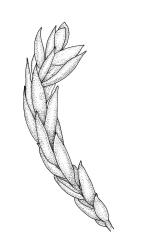Plants small or minute, dull, with creeping primary stems and ascendant secondary stems. Secondary stems fastigiately or subpinnately branched, mostly less than 15 mm long, in cross-section round or oval, with several (c. 5) layers of thick-walled outer cells and a central strand; rhizoids smooth, brown, scattered in sparse fascicles on ventral surface of stems; branches short, curved when dry. Primary stem leaves and branch leaves differentiated. Primary stem leaves erect when dry, ± spreading when moist, ovate-triangular and abruptly tapered to a narrow acumen, denticulate or entire. Secondary stem and branch leaves erect when dry, loosely spreading and concave to subtubulose when moist, ovate-lanceolate to elliptic-ovate, acute or obtuse, neither complanate nor decurrent, denticulate; upper and mid laminal cells rhombic to linear-rhombic, firm-walled and smooth, eporose; alar cells differentiated, quadrate or subquadrate, firm-walled, forming a large but ill-defined group extending nearly to the costa base and far up the basal margin; costa single, ending ⅔ or more the leaf length, stout or tapered, smooth or ending in abaxial spine. Axillary hairs reportedly present (not seen).
Autoicous. Perichaetia and perigonia scattered on stem and branches. Setae weakly papillose throughout (visible only under compound microscope), or smooth above; capsule obovoid, inclined. Exostome teeth yellow-brown, transversely striate below; endostome present, basal membrane reportedly weak. Calyptra cucullate and smooth.
Scorpiurium is a genus of fewer than five species distributed in western and southern Europe, western Asia, Macaronesia, and Australasia. It is traditionally distinguished from Eurhynchium and allied genera by having “large alar groups that extend far up along the stem and branch leaf margins and which consist of numerous shortly oblate to rectangular cells, and by the branches tending to be curved when dry” (Hedenäs 1996).
The placement of one Australasian species in Scorpiurium follows Hedenäs (1996, 2002). The Australasian S. cucullatum differs from the European S. circinatum in several ways, including (1) broader, more elliptic branch leaves, which are broadly acute or obtuse apically and more strongly concave, even subtubulose, when dry; and (2) shorter, less stout, and more tapered costae. Very limited sporophytic material of either species has been available for comparison. Future investigations may alter our view of the generic affinities of this species.
| Category | Number |
|---|---|
| Indigenous (Non-endemic) | 1 |
| Total | 1 |




